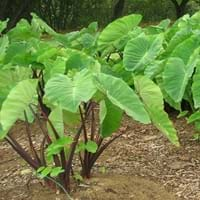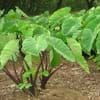Life Span
Annual
Perennial
Type
Tender Perennial
Flowering Plants
Origin
Southeastern Asia
Not Available
Types
Eddoe taro, Dasheen taro
Aconitum napellus
Habitat
agricultural areas, Hillside, Warm and moist climatic conditions
Damp shady woods, meadows
USDA Hardiness Zone
10-11
12-15
Sunset Zone
H1, H2, 22, 23, 24
21, 22, 23, 24
Habit
Clump-Forming
Oval or Rounded
Minimum Height
Not Available
Minimum Width
Not Available
Flower Color
White, Green
Yellow
Flower Color Modifier
Not Available
Not Available
Leaf Color in Spring
Dark Green, Ivory
Not Available
Leaf Color in Summer
Dark Green, Ivory
Not Available
Leaf Color in Fall
Dark Green, Ivory
Not Available
Leaf Color in Winter
Dark Green, Ivory
Not Available
Leaf Shape
V-Shaped
Compound
Plant Season
Spring, Summer, Fall, Winter
Not Available
Sunlight
Partial shade, Full Shade
Not Available
Growth Rate
Fast
Very Slow
Type of Soil
Loam, Sand
Not Available
The pH of Soil
Acidic, Neutral
Not Available
Soil Drainage
Well drained
Not Available
Bloom Time
Indeterminate
Spring
Repeat Bloomer
No
Not Available
Tolerances
Heat Tolerance, Humidity, Salt and Soil Compaction, Shallow soil
Not Available
Where to Plant?
Container
Ground
How to Plant?
From Rhizomes
reseeds
Plant Maintenance
Medium
Medium
Watering Requirements
Needs 2-3 times watering per week, Needs a lot of water initially
Do not let dry out between waterings
In Summer
Lots of watering
Lots of watering
In Spring
Moderate
Moderate
In Winter
Average Water
Average Water
Soil pH
Acidic, Neutral
Not Available
Soil Type
Loam, Sand
Not Available
Soil Drainage Capacity
Well drained
Not Available
Sun Exposure
Partial shade, Full Shade
Not Available
Pruning
No pruning needed
Remove damaged leaves, Remove dead branches, Remove dead leaves
Fertilizers
All-Purpose Liquid Fertilizer, Less fertilizing
All-Purpose Liquid Fertilizer
Pests and Diseases
Aphids, Rats, Snails
Red blotch
Plant Tolerance
Heat Tolerance, Salt and Soil Compaction, Shade areas
Drought
Flowers
Insignificant
Not Available
Flower Petal Number
Not Available
Single
Fragrant Flower
No
Not Available
Fragrant Fruit
No
Not Available
Fragrant Leaf
No
Not Available
Fragrant Bark/Stem
No
Not Available
Showy Foliage
Yes
Not Available
Showy Bark
No
Not Available
Foliage Texture
Bold
Bold
Foliage Sheen
Glossy
Not Available
Invasive
No
Not Available
Self-Sowing
No
Not Available
Attracts
Aphids, Bugs, Not Available, Snails
Hummingbirds
Allergy
Swelling in mouth, Throat itching
poisonous if ingested, Toxic
Aesthetic Uses
Showy Purposes
Not Used For Aesthetic Purpose
Beauty Benefits
Poison Ivy, Skin cleanser, Weightloss
Not Available
Environmental Uses
No fertilizer, pesticides, or herbicides needed, Prevent weeds
Air purification
Medicinal Uses
Aging, Laxative, Weight loss
Analgesic, Anodyne, Diaphoretic, Homeopathy, Used as a sedative
Part of Plant Used
Leaf Stalks, Leaves
Root
Other Uses
Used As Food, Used as Ornamental plant
Not Available
Used As Indoor Plant
No
No
Used As Outdoor Plant
Yes
Yes
Garden Design
Container, Feature Plant, Groundcover, Houseplant, Mixed Border, Tropical
Not Available
Botanical Name
ALOCASIA micholitziana
Aconitum
Common Name
Elephant Ear, Taro
aconite, monkshood, wolf's bane, leopard's bane, mousebane, women's bane, devil's helmet, Queen of all Poisons, blue rocket
In German
Colocasia (Pflanzengattung)
Eisenhut
In French
Colocasia
Queen of all Poisons
In Spanish
Colocasia
Queen of all Poisons
In Greek
Colocasia
Queen of all Poisons
In Portuguese
Colocasia
Queen of all Poisons
In Polish
Kolokazja
Tojad
In Latin
Colocasia
Queen of all Poisons
Phylum
Magnoliophyta
Tracheobionta
Class
Liliopsida
Magnoliopsida
Order
Arales
Ranunculales
Clade
Angiosperms, Monocots
Angiosperms, Eudicots
Tribe
Colocasiodeae
Delphinieae
Subfamily
Aroideae
Not Available
Difference Between Taro and Queen of all Poisons
If you are confused whether Taro or Queen of all Poisons are same, here are some features about those plants to help you choose better. Many people think that these two plants have the same characteristics, but one can see Taro and Queen of all Poisons Information and learn more about it. Fertilizers required for proper growth of Taro are All-Purpose Liquid Fertilizer and Less fertilizing, whereas for Queen of all Poisons fertilizers required are All-Purpose Liquid Fertilizer. Hence, one should know the basic difference between Taro and Queen of all Poisons if you are planning to have them in your garden to enhance its beauty.
<
Flowering PlantsImportance of Taro and Queen of all Poisons
Want to have the most appropriate plant for your garden? You might want to know the importance of Taro and Queen of all Poisons. Basically, these two plants vary in many aspects. Compare Taro and Queen of all Poisons as they differ in many characteristics such as their life, care, benefits, facts, etc. Every gardener must at least have the slightest clue about the plants he wants to plant in his garden. Compare their benefits, which differ in many ways like facts and uses. The medicinal use of Taro is Aging, Laxative and Weight loss whereas of Queen of all Poisons is Analgesic, Anodyne, Diaphoretic, Homeopathy and Used as a sedative. Taro has beauty benefits as follows: Poison Ivy, Skin cleanser and Weightloss while Queen of all Poisons has beauty benefits as follows: Poison Ivy, Skin cleanser and Weightloss.
Compare Facts of Taro vs Queen of all Poisons
How to choose the best garden plant for your garden depending upon its facts? Here garden plant comparison will help you to solve this query. Compare the facts of Taro vs Queen of all Poisons and know which one to choose. As garden plants have benefits and other uses, allergy is also a major drawback of plants for some people. Allergic reactions of Taro are Swelling in mouth and Throat itching whereas of Queen of all Poisons have poisonous if ingested and Toxic respectively. Having a fruit bearing plant in your garden can be a plus point of your garden. Taro has no showy fruits and Queen of all Poisons has no showy fruits. Also Taro is not flowering and Queen of all Poisons is not flowering . You can compare Taro and Queen of all Poisons facts and facts of other plants too.





